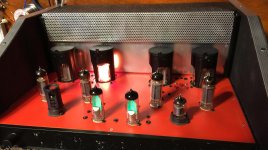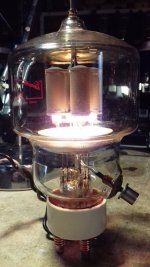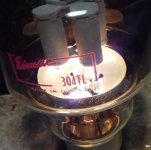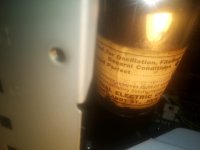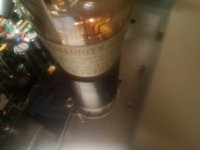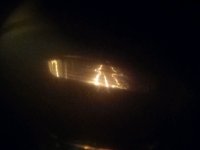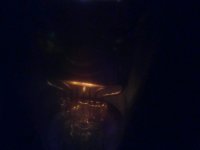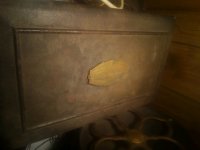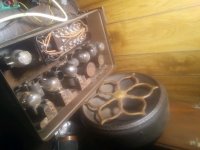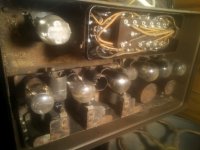^ nice! Interesting that some show fluorescence and others not, is that one particular type of tube? I.e the 12SN7
Kyuss fan, by any chance? Guessing from your username.
12SN7GTA's are all RCA.
Yes, I'm fond of Kyuss QOTSA among others.
Orange Gu-50 anode. Why? It run away, was gassy. After that external anode surface absorbed gases, and the tube runs like new.
hmm do they have a zircon/titan plated plates ???
wen you want use nos transmitting tube you should read this before :
Radio tube reconditioning
no getter tubes go bad if you do not follow minimum reactivation to free thems from gas
Radio tube reconditioning
no getter tubes go bad if you do not follow minimum reactivation to free thems from gas
i just find nos 304TL811a, 845, 211, and 304tl are all amazing glowing devices!
Attachments
hmm do they have a zircon/titan plated plates ???
Something like that, on the external surface of nickel alloy plates.
One guy who served in a military intelligence said that they even had an instruction, in order to reduce power of transmitting to detune antenna until anodes got cherry-red glow. 😀
Orange Gu-50 anode. Why? It run away, was gassy. After that external anode surface absorbed gases, and the tube runs like new.
life its very very short so enjoy,
life its very very short so enjoy,
I run it recently, no problem, after several years on a shelf. Looks like cured.
Wavebourn - Pyramid - VII amplifier driving JBL L5 speakers | Facebook
Thread revival🙂.
So these very old UX201A battery triodes, still working reliability well (I try to create an "ideal" operating condition for them, they are very old , far older than anyone posting on this forum is, I would suspect, even George😀), but evidently still fully functional at: (120V, 2.5mA, with a P-ch J-fet (cascode) CCS plate load, driving a very high Z load (a small signal BJT diamond buffer, virtually non-existent😀). So it is a single ended VAS, with a low feedback factor. The gain of these devices may be low but linearity is very good.🙂 I've come to the conclusion that they do make very good amplifiers.
, far older than anyone posting on this forum is, I would suspect, even George😀), but evidently still fully functional at: (120V, 2.5mA, with a P-ch J-fet (cascode) CCS plate load, driving a very high Z load (a small signal BJT diamond buffer, virtually non-existent😀). So it is a single ended VAS, with a low feedback factor. The gain of these devices may be low but linearity is very good.🙂 I've come to the conclusion that they do make very good amplifiers.  The PS employs a 240mA floating filament CCS, (slow rise/slow fall). +/-30V swing on the (plate = output) and of course, always to admire the wonderful thoriated tungsten glow of yesteryear as was the case when purchased by my grandpa back in '27 and '31.
The PS employs a 240mA floating filament CCS, (slow rise/slow fall). +/-30V swing on the (plate = output) and of course, always to admire the wonderful thoriated tungsten glow of yesteryear as was the case when purchased by my grandpa back in '27 and '31.
 all adds up to....
all adds up to....
 ....such precise sound
....such precise sound
 .
.
Yo!
I wish they still made something like these triodes today.

I find these devices to be not so difficult to marry with SS, with direct coupled circuitry. They seem to follow closely to the datasheet from '25. . The question is, given these operating conditions, how much time is left on the filaments? I only have 5 tubes and they are not easy to come by in this, the extended relative future.
. The question is, given these operating conditions, how much time is left on the filaments? I only have 5 tubes and they are not easy to come by in this, the extended relative future.
I do use this amplifier alot, many hours. Given the stated operating conditions, maybe more knowledgeable folks here can pinpoint what else might be deteriorating factors leading to the demise of these elderly triodes and what other conditions might help to extend their glow time?
So these very old UX201A battery triodes, still working reliability well (I try to create an "ideal" operating condition for them, they are very old
 , far older than anyone posting on this forum is, I would suspect, even George😀), but evidently still fully functional at: (120V, 2.5mA, with a P-ch J-fet (cascode) CCS plate load, driving a very high Z load (a small signal BJT diamond buffer, virtually non-existent😀). So it is a single ended VAS, with a low feedback factor. The gain of these devices may be low but linearity is very good.🙂 I've come to the conclusion that they do make very good amplifiers.
, far older than anyone posting on this forum is, I would suspect, even George😀), but evidently still fully functional at: (120V, 2.5mA, with a P-ch J-fet (cascode) CCS plate load, driving a very high Z load (a small signal BJT diamond buffer, virtually non-existent😀). So it is a single ended VAS, with a low feedback factor. The gain of these devices may be low but linearity is very good.🙂 I've come to the conclusion that they do make very good amplifiers.  The PS employs a 240mA floating filament CCS, (slow rise/slow fall). +/-30V swing on the (plate = output) and of course, always to admire the wonderful thoriated tungsten glow of yesteryear as was the case when purchased by my grandpa back in '27 and '31.
The PS employs a 240mA floating filament CCS, (slow rise/slow fall). +/-30V swing on the (plate = output) and of course, always to admire the wonderful thoriated tungsten glow of yesteryear as was the case when purchased by my grandpa back in '27 and '31.
 all adds up to....
all adds up to....
 ....such precise sound
....such precise sound
 .
. Yo!

I wish they still made something like these triodes today.


I find these devices to be not so difficult to marry with SS, with direct coupled circuitry. They seem to follow closely to the datasheet from '25.
 . The question is, given these operating conditions, how much time is left on the filaments? I only have 5 tubes and they are not easy to come by in this, the extended relative future.
. The question is, given these operating conditions, how much time is left on the filaments? I only have 5 tubes and they are not easy to come by in this, the extended relative future.I do use this amplifier alot, many hours. Given the stated operating conditions, maybe more knowledgeable folks here can pinpoint what else might be deteriorating factors leading to the demise of these elderly triodes and what other conditions might help to extend their glow time?
Attachments
Last edited:
I would suspect, even George
One of my TSE's runs output tubes that are 20+ years older than me. I turn 67 in a few days. It has a pair of National Union NX-483's that I pulled out of a Sparton radio chassis that had turned to rust. The tubes have stickers on them bearing a date in 1929. They have been in that amp for about 15 years, and still work great.
Wow. I would think that power tubes would generally have a lower life span because of greater heat cycling on the electrodes. But then you wouldn't be the type of guy to over-extend the operating range of a valve, LoL😀. I guess like an old car, it last longer if you don't dogg it.
I am generally quite the noob in working with valves, a SS breakout , my interest is growing. I regard them akin sort of to J-fets WRT audio, very interesting similarities, at least for triodes.
, my interest is growing. I regard them akin sort of to J-fets WRT audio, very interesting similarities, at least for triodes.
I am generally quite the noob in working with valves, a SS breakout
 , my interest is growing. I regard them akin sort of to J-fets WRT audio, very interesting similarities, at least for triodes.
, my interest is growing. I regard them akin sort of to J-fets WRT audio, very interesting similarities, at least for triodes.
Last edited:
Happy Birthday George!
May you live beyond the span of time of the tubes that we are speaking of.🙂
May you live beyond the span of time of the tubes that we are speaking of.🙂

The other radio that Gramps had is a 1928 Atwater Kent. I believe that this unit is restorable, and I intend to do so but the PS is FUBAR, but that can be remedied. The electrostatic speaker seems to be in good condition. I've cleaned most of the arachnid webs from it.🙄
If it is worth the restoration.
If it is worth the restoration.
Attachments
Last edited:
Given no-one exceeds the nominal heater voltage, do thoriated tungsten filaments deteriorate at all? If so, by which cause?
Best regards!
Best regards!
I expect like other cathodes, they just run out of emission. I have 572B that are no good for RF, but I've kept them around to make night lights from, as they still light up like new.
The Svetlana (Ryazan) 811-A in my linear are getting a little soft after two decades, but I can still get 450-500 watts output at 28 MHz from a triplet of them.
The Svetlana (Ryazan) 811-A in my linear are getting a little soft after two decades, but I can still get 450-500 watts output at 28 MHz from a triplet of them.
Running out of emission is easily understandable for barium oxide coated cathodes, due to evaporation of the barium. But will thorium also evaporate?
Best regards!
Best regards!
Member
Joined 2009
Paid Member
The Thorium is inside the wire, if it loses too much from the surface I heard that there is a temperature cycle you can put them through to migrate fresh material to the surface of the wire.
That's what I recall - the Thorium compound is mobile, and eventually what's left can't get to the surface of the emitter.
Best I recall, the installation procedure for new thoriated tungsten transmitting tubes is to apply filament voltage and current for 24 hours prior to application of plate voltage to prepare the filament for use.
It's said a few per cent under filament voltage spec will extend the tube life. A few percent over spec greatly reduces it.
Best I recall, the installation procedure for new thoriated tungsten transmitting tubes is to apply filament voltage and current for 24 hours prior to application of plate voltage to prepare the filament for use.
It's said a few per cent under filament voltage spec will extend the tube life. A few percent over spec greatly reduces it.
I built a little SE 6l6 / 6sl7 amp out of lexan that looks pretty cool with the B+ on. The 6l6’s are old Sylvanias that I plucked out of an old X-ray machine in the junkyard. They have a nice glow but one is definitely brighter. Don’t know why.
If i recollect, my 6551 did this too in various amounts. The screen voltage had to be lowered a bit. I had heard that with the blue emission the life is shortened.
So if one like that blue color: increase the screen supply!
...The electrostatic speaker seems to be in good condition....
IMHO: unlikely to be electrostatic. Balanced Armature more likely. Especially if the cone has a small rod glued in the center.
BA drivers have become "obsolete" with the declining cost of electronic amplification, but I am listening to one now.
- Home
- Amplifiers
- Tubes / Valves
- tubes with the best 'glow'
